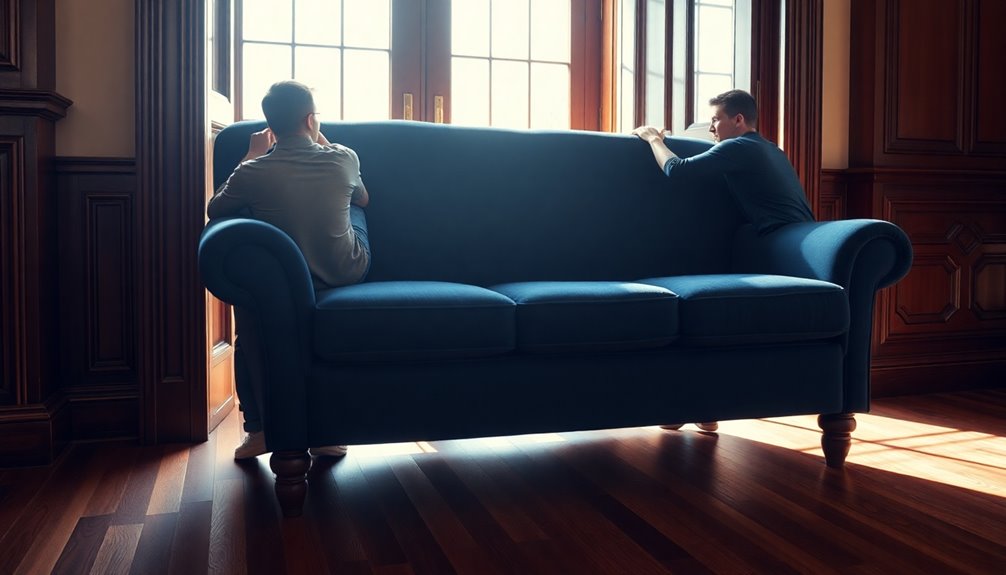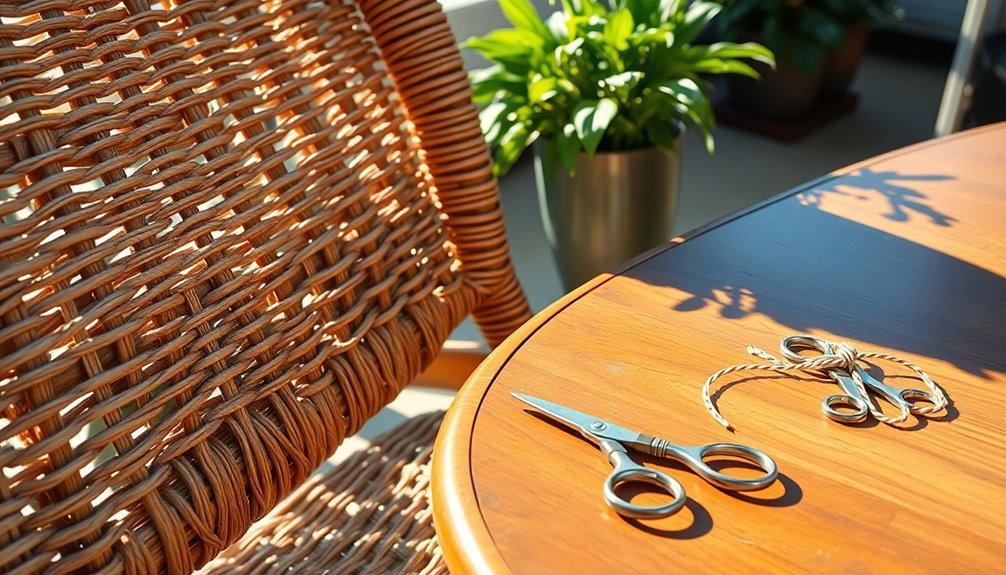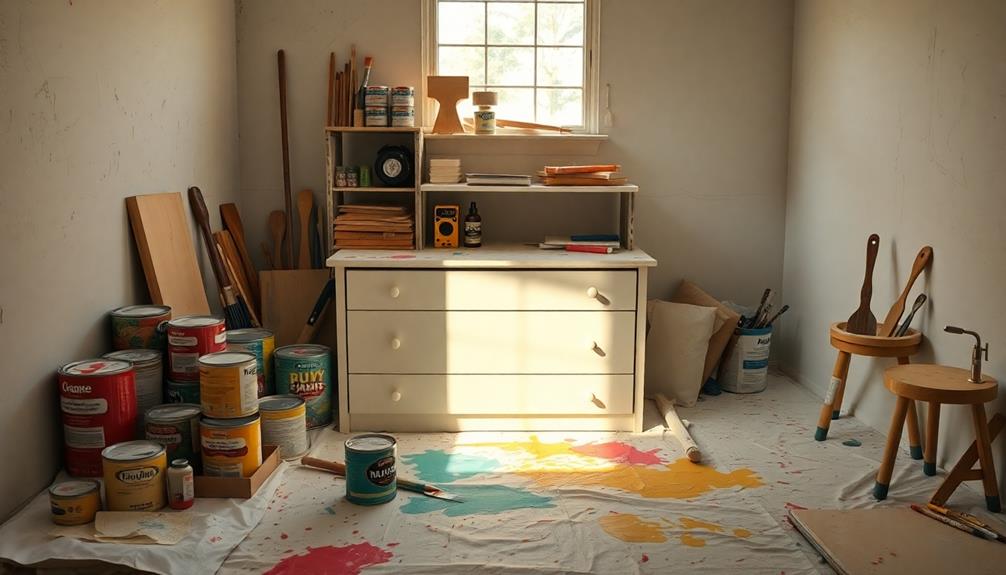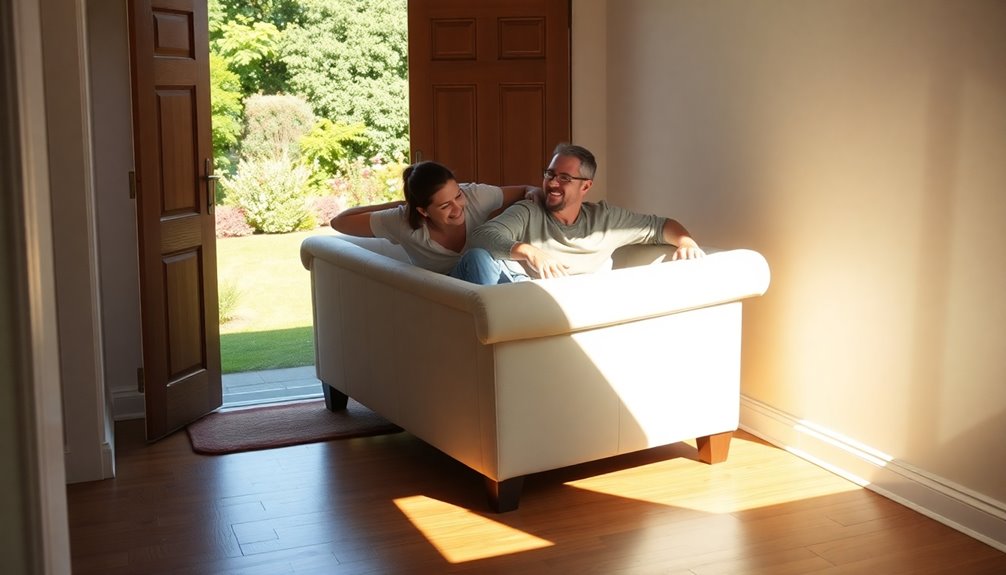To fit your sofa through a door, start by measuring its dimensions and the door frame. Angle the sofa diagonally to utilize as much space as possible. If it's too wide, consider removing the legs or any detachable parts. Clear the area of obstacles like furniture or decorations to make room. You might also want to slightly tilt the sofa back, allowing it to slip more easily through the doorway. With these tips, you'll have a higher chance of success. Want to know some other helpful tips for ensuring a smooth moving process?
Key Takeaways
- Measure both the sofa's dimensions and the door's size to ensure a proper fit before attempting to move it.
- Remove any removable cushions or parts from the sofa to reduce its overall size during the maneuver.
- Tilt the sofa at an angle to navigate through the doorway, allowing it to fit more easily.
- Use a blanket or padding to protect the sofa and door frame from potential damage during the move.
- Enlist help from another person to manage the sofa's weight and angles for a smoother transition through the door.
Introduction
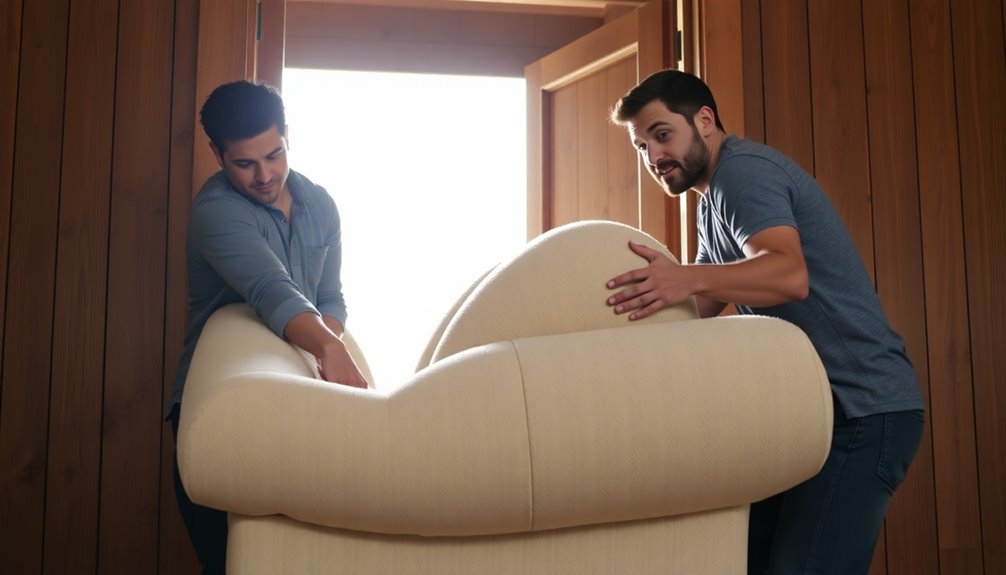
When you bring a new sofa home, it's important to think about its care right from the start. You'll want to know routine fabric care tips and fabric-specific cleaning techniques to keep it looking great. Plus, if spills happen, like red wine accidents, having a plan can save you a lot of trouble down the line.
Routine Fabric Care Tips
Taking care of your fabric sofa is essential to keep it looking fresh and lasting longer. Start by regularly vacuuming your sofa to remove dust, dirt, and allergens. Use an upholstery attachment to prevent damage to the fabric fibers. When spills happen, it's crucial to spot clean immediately. Create a mild detergent and water solution, but be sure to test it on a hidden area first to ensure colorfastness.
To maintain the shape of your cushions and prevent uneven wear, rotate and fluff them weekly. This small effort goes a long way in ensuring both longevity and comfort. Additionally, consider using fabric protectors. These create a barrier against stains and spills, but remember to reapply them as recommended by the manufacturer for continued effectiveness.
Lastly, always follow the care instructions provided on your sofa's tag. Different fabrics require specific cleaning methods and products to avoid damage, so keeping these guidelines in mind is crucial. By implementing these routine fabric care tips, your sofa will not only look great but also stand the test of time.
Fabric-Specific Cleaning Techniques
Regularly cleaning your fabric sofa is essential for maintaining its appearance and longevity, but the right approach depends on the type of fabric. First, check the care label for specific cleaning techniques. For synthetic fabrics like polyester, a simple mixture of vinegar and water can effectively tackle odors and stains without harming the material. If you have a microfiber sofa, you can use a damp cloth and mild soap to wipe away dirt.
Cotton upholstery often requires a fabric-safe cleaner or steam cleaning, especially for tough stains. Natural fibers, such as wool, should be treated with specialized wool cleaners to prevent shrinkage and maintain texture; avoid using excessive moisture.
To keep your sofa looking its best, regular maintenance is key. Vacuum your upholstery weekly to remove dust and debris, and address spills promptly to prevent stains from setting. By following these fabric-specific cleaning techniques, you'll ensure that your sofa remains in excellent condition, enhancing both its durability and aesthetic appeal for years to come.
Treating Red Wine Spills
Red wine spills can be a nightmare for your upholstery, but acting quickly can make all the difference. First, grab a clean, dry cloth and gently blot the stain to absorb as much liquid as possible—don't rub it, as that can spread the stain. If you have white wine and club soda on hand, mix them together and apply the solution to neutralize the red wine. Blot gently to lift the color.
For stubborn stains, you can create a paste with baking soda and water. Apply this paste to the stain and let it sit for several hours before rinsing it off. Baking soda helps absorb the pigment effectively. If you prefer, commercial stain removers designed specifically for wine stains can be a great option; just follow the manufacturer's instructions.
Once you've treated the stain, rinse the area with cold water and blot it dry. This will prevent any remaining residue from setting into the fabric or carpet. If the stain persists despite your efforts, it might be time to consider professional assistance, especially if you're dealing with delicate fabrics. You don't want to risk damaging your couch while trying to move it through a narrow doorway or after removing the door. Additionally, maintaining good oral hygiene habits can help prevent stains from occurring in the first place.
Sofa Stain Resistance Treatments
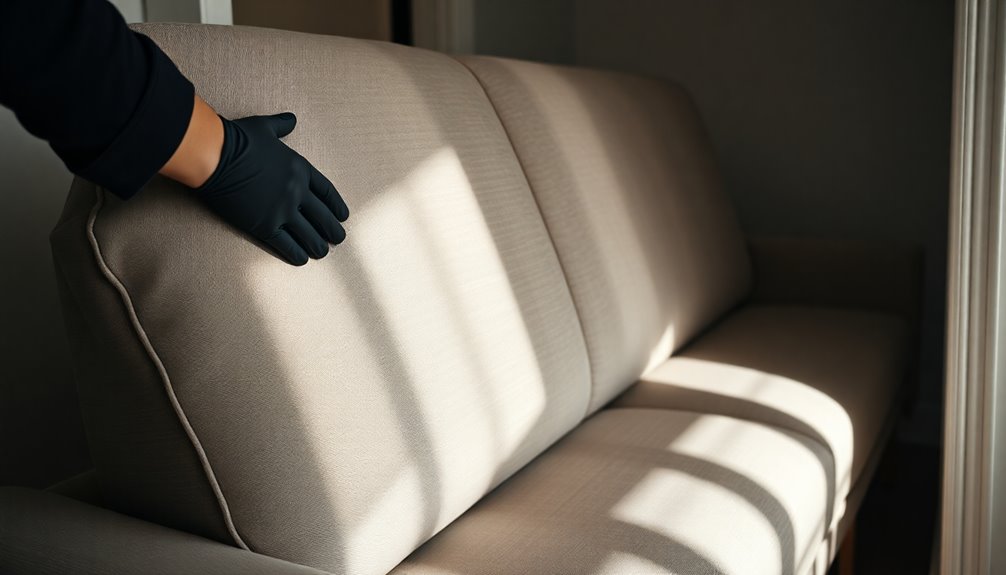
When picking a sofa, consider water-resistant fabric options that can keep spills at bay. You might also want to think about employing decorative fabric layers for added protection and style. Lastly, using fabric protectors can enhance your sofa's durability and make cleaning a breeze.
Water-Resistant Fabric Options
Choosing the right water-resistant fabric for your sofa can significantly enhance its durability and ease of maintenance. Fabrics like polyester and acrylic often come treated with coatings that repel liquids and stains, making them perfect for households with pets or children. If you have heavy couches, you'll appreciate options like performance fabrics, including Sunbrella, designed to be both water-resistant and fade-resistant, ensuring they last while looking great.
Take note that stain resistance treatments, such as Teflon or Scotchgard, can also be applied to natural fibers like cotton and linen. This will improve their durability against spills. Some brands even offer specialized water-repellent finishes that can withstand up to 30 minutes of water exposure, giving you a buffer against accidental spills before you need to worry about sofa disassembly for cleaning.
Regular maintenance is key. Many water-resistant fabrics are machine washable, while others may need professional cleaning to maintain their water-resistant properties. By choosing the right fabric and caring for it properly, you'll keep your sofa looking fresh and prolong its lifespan.
Employing Decorative Fabric Layers
Incorporating decorative fabric layers can significantly boost your sofa's resistance to stains, allowing you to enjoy your furniture without constant worry about spills. When you're moving large items, a couch that's treated with stain-resistant materials can save you hassle in the long run. Fabrics like microfiber and polyester often come with built-in stain resistance, meaning they're easier to clean and maintain compared to natural fibers like cotton or linen.
For added protection, applying a protective fabric spray can create a barrier against spills, ensuring your sofa maintains its appearance. Additionally, choosing darker colors or patterns can help mask any stains or wear, while lighter fabrics might need more frequent cleaning and treatment. Regular maintenance, like vacuuming and promptly addressing spills, can prolong the effectiveness of these stain-resistant treatments.
Using Fabric Protectors
Fabric protectors are essential for anyone looking to keep their sofa looking fresh and clean. These treatments create a barrier on your upholstery, making it more resistant to stains and spills. By repelling liquids, fabric protectors prevent absorption, which helps maintain your sofa's appearance and integrity over time.
When you apply a fabric protector, you're not just enhancing your sofa's look; you're significantly extending its lifespan. Many products utilize advanced technology, such as fluorochemicals, offering long-lasting protection against dirt, oil, and water-based stains. However, remember that the effectiveness of fabric protectors can diminish over time, especially with regular cleaning and wear. It's recommended to reapply every 6 to 12 months to ensure continued protection.
If you're concerned about safety, you'll be pleased to know that some fabric protectors are environmentally friendly and non-toxic. This makes them an excellent choice for homes with children and pets, allowing you to enjoy robust stain resistance without compromising your family's health. So, for a sofa that stands the test of time, consider investing in a high-quality fabric protector.
Routine Upholstery Inspections
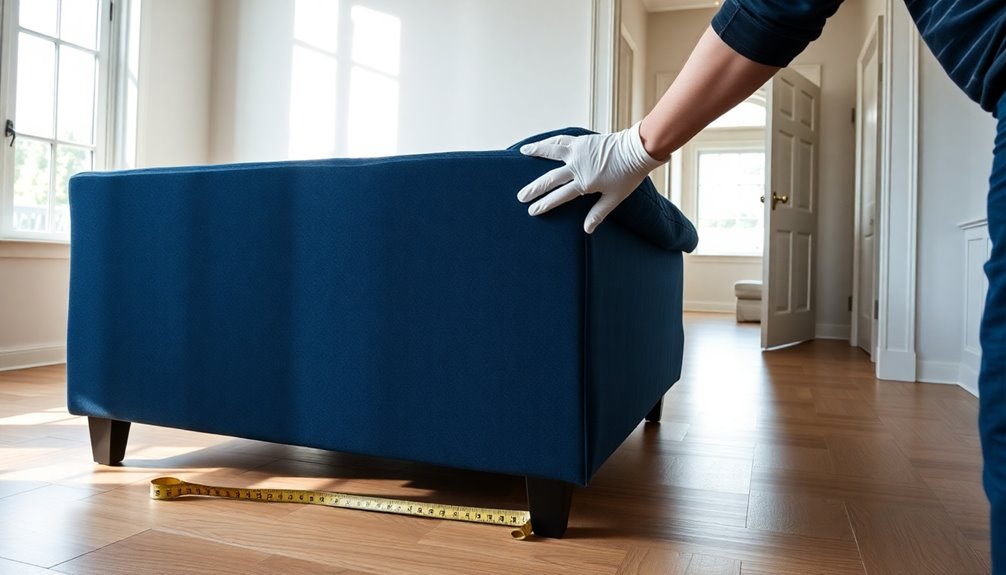
You should regularly inspect your upholstery to catch any frame integrity concerns early on. It's also a good time to consider leather repair techniques if you notice any scratches or wear. Plus, don't forget to fluff your cushions to keep them looking fresh and comfortable.
Frame Integrity Concerns
When moving a sofa, the last thing you want is to encounter frame integrity issues. A compromised frame can drastically affect your furniture's stability and longevity. That's why routine upholstery inspections are essential. Start by checking for warping, cracking, or splitting in the wood or metal parts of the frame. These signs can indicate serious structural problems that could worsen during your move.
Next, ensure that all joints and connections are secure. Loose or damaged joints can lead to further deterioration, especially while navigating tight spaces. You don't want your couch collapsing under pressure.
It's also crucial to assess the weight distribution of the sofa. Improper weight distribution can put undue stress on the frame, increasing the risk of damage as you maneuver through doorways.
During your inspections, document any findings to maintain a history of the sofa's condition. This information can be invaluable for future repairs or even when considering resale value. Remember, keeping your sofa in its proper place requires ongoing attention to frame integrity. This proactive approach ensures a smoother moving experience and a longer life for your cherished furniture.
Leather Repair Techniques
In the world of furniture care, leather upholstery demands regular attention to keep it looking pristine and prolong its lifespan. Start by routinely inspecting your leather for signs of wear, such as cracks, discoloration, and scuffs. Catching these issues early can significantly enhance the longevity of your sofa. For cleaning, use a soft cloth and a mild soap solution, ensuring to follow up with a leather conditioner to maintain suppleness and prevent drying.
If you notice minor scratches, applying a leather repair cream that matches your sofa's color can help conceal imperfections and restore its finish. For more significant damage, consider investing in a leather repair kit, which typically includes patches, adhesive, and color compounds. Be sure to match the color precisely for seamless repairs.
Additionally, scheduling professional upholstery inspections at least once a year is crucial. These experts can identify underlying issues that might not be visible to the untrained eye and provide tailored advice on maintaining your leather upholstery. By following these steps, you'll ensure that your leather furniture stays beautiful and functional for years to come.
Cushion Fluffing Techniques
Maintaining the comfort and appearance of your sofa relies heavily on regular cushion fluffing techniques. To keep your piece of furniture looking its best, make it a habit to fluff the cushions every few weeks. Start by gently kneading and reshaping the cushions with your hands, focusing on areas that get the most use, like the seat and back cushions. This helps prevent flattening and maintains their shape.
Don't forget to rotate and flip the cushions periodically. This promotes even wear and extends their lifespan, ensuring your sofa remains inviting. If you notice dirt or debris, vacuum the cushions using an upholstery attachment for a thorough clean.
For down or fiber-filled cushions, consider using a fabric refresher or steam to revive their loft and softness. This keeps them plush and comfortable for lounging. If you ever need to maneuver your sofa through a tight door, remember that a bit of couch disassembly may be necessary, and you might need to remove the door for a safe and efficient fit. By following these cushion fluffing techniques, you'll keep your sofa looking and feeling great for years to come.
Custom Cushion Sizes
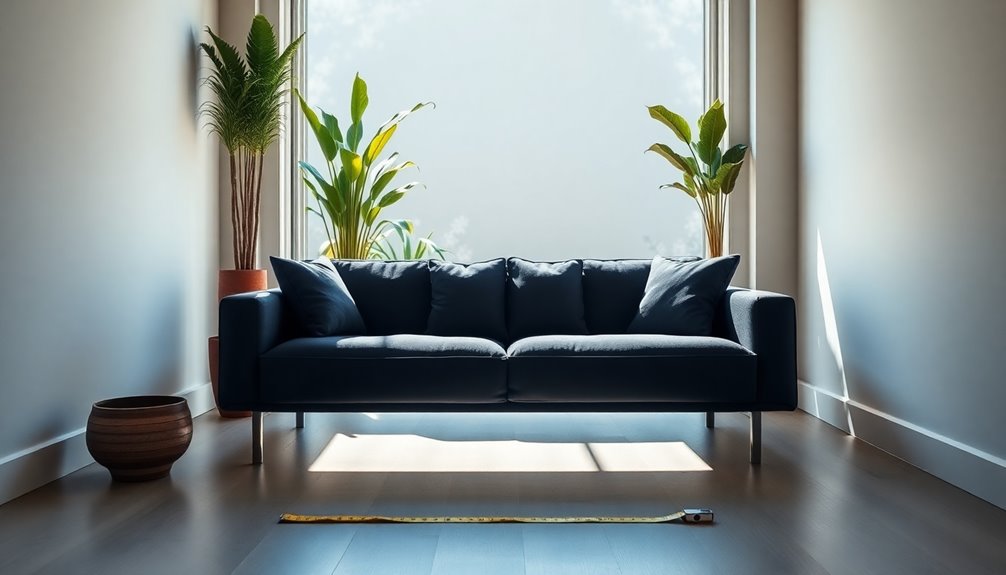
Fitting custom cushions perfectly to your sofa involves precise measurements for length, width, and thickness. To ensure your cushions not only fit your sofa but also make it easier to fit through the door, you must provide accurate measurements. When you order custom cushion sizes, consider how the cushions will align with your sofa's frame and style to enhance its overall look.
Many manufacturers offer a variety of foam densities and materials for custom cushions, allowing you to choose your ideal level of personalized comfort. This selection process is key; it helps you find cushions that provide the right support while fitting snugly against your sofa. Additionally, opting for removable covers is a smart choice. These covers make cleaning a breeze and let you customize the fabric to match your decor.
Seasonal Fabric Storage Tips
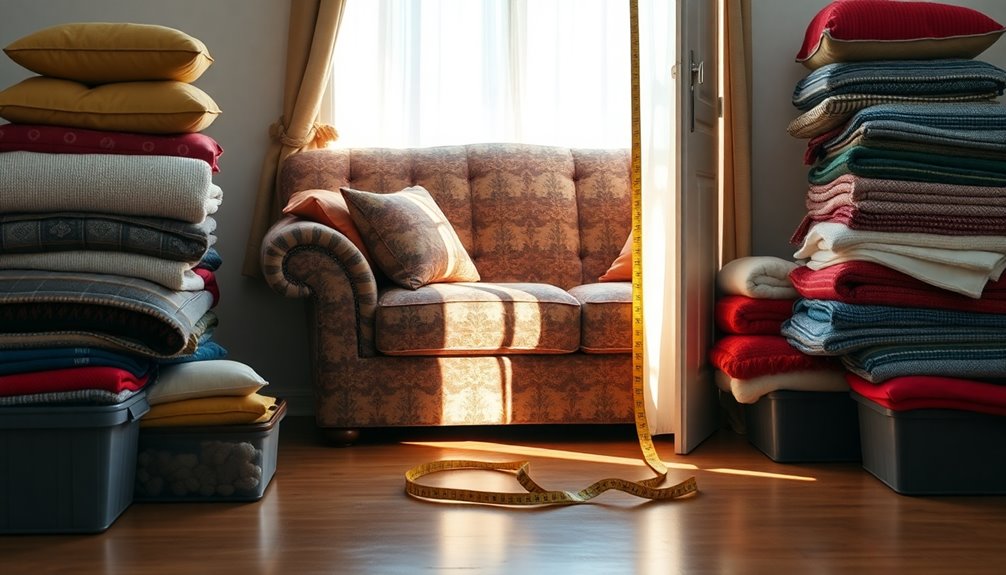
Properly storing seasonal fabrics is essential for keeping them in great condition until you need them again. Start by cleaning all fabric items according to their care labels. This step prevents stains from setting in during storage, ensuring your seasonal fabrics look fresh when you pull them out next time.
Next, choose breathable storage containers, like cotton bags or bins, to protect fabrics from moisture and pests. A cool, dry environment is ideal for storing your items, away from direct sunlight to avoid fading and deterioration.
To further safeguard your fabrics, consider adding cedar blocks or lavender sachets in your storage containers. These natural repellents not only protect against insects but also keep your fabrics smelling pleasant.
Finally, label your storage containers clearly with the contents and season. This makes it easier for you to locate items when needed, saving you time and reducing frustration. By following these tips, you can ensure your seasonal fabrics remain in excellent condition, ready for their next use.
Conclusion
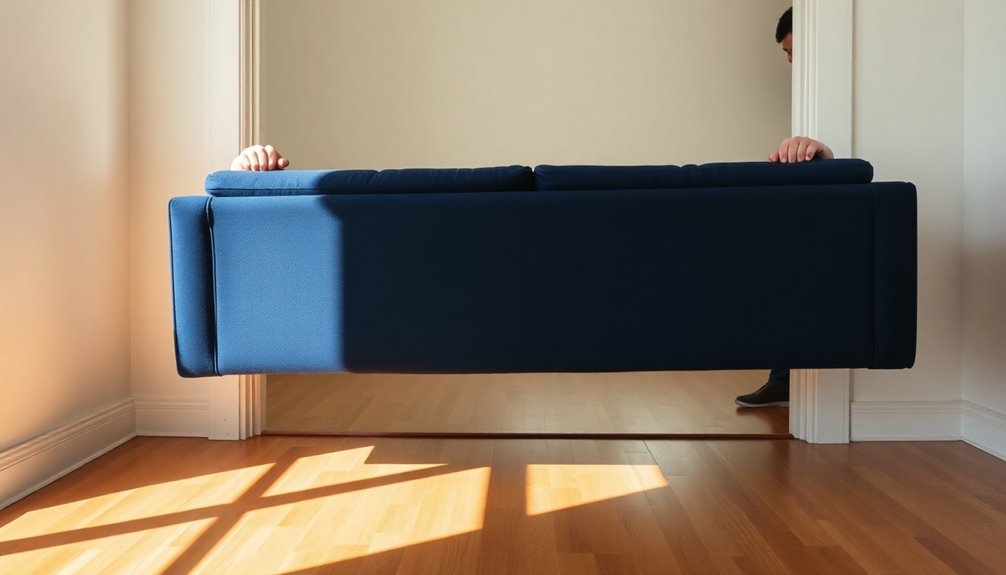
When it comes to fitting a sofa through a door, planning ahead is key to a smooth process. Start by measuring both your sofa and the doorway. If your sofa is 78 inches wide and the door is only 29 inches, you'll face maneuverability issues. Consider removing the hinges or even the door itself to gain up to 1.5 inches of extra clearance. This small adjustment might make all the difference.
Next, think about the best way to move the sofa. Pivoting it at a 45-degree angle can help you navigate those narrow spaces more effectively, especially if the sofa has removable legs or components. Visualizing fitting angles by drawing a triangle can guide you in determining the best approach to maneuver the sofa through the opening without causing damage.
If you feel unsure or if the space is particularly challenging, don’t hesitate to engage professional movers. They have the experience and tools to safely move oversized sofas, ensuring a hassle-free delivery. With careful planning and the right techniques, you can successfully fit your sofa through that doorway and enjoy your new furniture in no time. Additionally, if you encounter major obstacles, researching how to disassemble a sofa bed may be beneficial. This knowledge can greatly simplify the moving process, allowing you to navigate tight spaces with ease. By breaking down your furniture into manageable parts, you can ensure that everything arrives at your new home without a scratch.
Frequently Asked Questions
What if My Sofa Doesn't Fit Through the Door?
If your sofa doesn't fit through the door, don't panic! First, measure both the sofa and the door to see how much space you have. You might try removing the door entirely for extra width. Consider disassembling the sofa by taking off legs or backrests to make it smaller. Use pivoting techniques to maneuver through tight spaces. If you're still stuck, hiring professional movers can be a smart solution to avoid damage.
How to Make Sure a Sofa Fits Through a Door?
To make sure a sofa fits through a door, start by measuring its height, width, and depth. Compare these measurements with the door dimensions and check for any obstructions along the path. Consider disassembling the sofa by removing cushions or legs to reduce size. When transporting, use a pivot technique by tilting the sofa at a 45-degree angle to align it with the door frame. If needed, remove door hinges for extra clearance.
How Do You Get a Large Sofa Through the Door?
To get a large sofa through the door, start by measuring both the sofa and the doorway. Remove any cushions or legs to minimize size. Tilt the sofa at a 45-degree angle for better maneuverability, using the pivot technique to navigate tight spots. If it's still too big, consider taking the door off its hinges for extra clearance. If none of this works, disassemble the sofa or hire professional movers for assistance.
Can You Dismantle a Sofa to Fit Through a Door?
Yes, you can dismantle a sofa to fit through a door. Start by removing detachable parts like legs, cushions, and backrests, which can significantly reduce its size. Use basic tools, and keep track of screws and small parts in labeled bags for easy reassembly. Documenting the disassembly process helps ensure you put it back together correctly later. If it's too complex, consider hiring professionals for safe handling and fitting through tight spaces.
